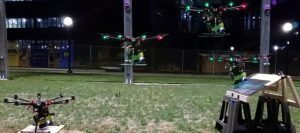We’re flying about 5,000 feet above rural New York in a Cirrus Vision Jet when the pilot has what appears to be a heart attack. He lets go of the controls and slumps forward in his seat, leaving me—not a pilot—to fly the airplane to safety. I reach behind me, press a big red button in the ceiling of the cabin, stop worrying about the plane and concentrate on trying to resuscitate my fallen companion. Fifteen minutes later, the plane touches down at a remote airstrip.
This scenario, thankfully, was playacting, though not as far from the truth as you might think. My pilot, Matt Bergwall, remained perfectly healthy and alert during this demonstration. But we were indeed over rural New York. Bergwall did in fact invite me to land the airplane in his stead. And I did push a bright red button and watch the small jet find its way to that airstrip, descend, and put rubber to tarmac all on its own.
Want the latest aviation news in your inbox? Sign up here!
That was thanks to the Safe Return Emergency Autoland System, developed by avionics company Garmin with input from aircraft manufacturers including Cirrus and Piper, both of which unveiled the technology this week. When activated, it finds the nearest suitable airport, calculates a flight path that avoids mountains and menacing storm fronts, communicates with air traffic control, and autonomously guides the aircraft onto the runway and to a complete stop. It could have also notified emergency services; Cirrus disabled that function for the demo.
The button that activates the system is easily accessible from both the front seats and the passenger seats behind them.
Photograph: Jeff Frey/CirrusThis isn’t the first feature of its kind, but it’s certainly the most capable. Other commercial autoland systems require continuous oversight by a trained pilot, and are only meant to assist if one of two pilots becomes incapacitated. The tablet-based app Xavion provides similar functionality for private aircraft, but it, too, requires a degree of oversight, and is mostly meant for engine failure situations, with the pilot taking over the glide during the final approach.
What’s novel about Cirrus’ system is that it gives the power of flight to even the noobiest of passengers. That red button is easily accessible from both the front seats and the passenger seats behind them, and Safe Return is hardwired into the $2 million Vision Jet’s controls, using autopilot functionality and the small jet’s simplified engine management system to steer the aircraft to a smooth landing and brake to a stop.
“Over the years, we’ve been adding things to our airplanes such as situational awareness tools and things that simplify control or lower pilot workload,” Bergwall says. “But now, for the first time, we actually have a safety system that is really just for the passengers.” It can also, of course, be used by pilots themselves if they suffer any medical emergency, or even disorientation or uncertainty while at the controls.
The technology is an upshot of the avionics Cirrus and Garmin developed for the Vision Jet, an “entry level” business jet introduced in 2016 that’s typically flown by the private owner rather than professional pilots. The Safe Return system, which can also be used in turboprop aircraft, works with Garmin’s G3000 avionics suite, which features integrated control of all airplane systems, including the engine management, landing gear activation, control-surface movement, and the navigation, weather, and traffic-monitoring systems.
When someone hits the button, the system selects the airport that has the best combination of runway length and a clear approach relative to the weather conditions. It then steers the airplane on a descent, alerting local traffic and air traffic control to the emergency via preprogrammed text and spoken-word messages it can voice itself over the radio. It deploys the landing gear, adjusts the flaps to maintain lift as the airspeed slows, and uses precision GPS, along with radar information, to bring it down at the exact right spot. Though the system can shut down the engine if necessary—important for aircraft with spinning propellers—Cirrus elected to keep its single engine running after the stop, since it is mounted on top of the aircraft and thus won’t hurt anyone approaching or exiting the plane. This keeps the climate control active inside and allows for taxiing if the pilot or passengers are able to do so.
During the descent, the system uses the instrument panel monitors to give passengers instructions for preparing for landing, along with a play-by-play of what’s happening.
Photograph: Eric AdamsDuring the descent, the system uses the instrument panel monitors to give passengers instructions for preparing for landing, along with a play-by-play: aircraft climbing to reach a specific altitude, descending toward the airport, landing in however many minutes, and so forth. If someone accidentally hits the button during flight, the pilot can cancel the landing sequence simply by taking over the controls. If the system is deliberately engaged but someone accidentally turns it off, another touch of the button will reengage it.
The capability introduced by Safe Return—complemented by a rocket-deployed, whole-aircraft parachute in the Cirrus jet that can fire if the situation becomes even more dire—promise to make the Vision Jet one of the safest private aircraft in the world. But the system won’t be exclusive to Cirrus for long. Within a few months, Garmin will be able to offer it to other aircraft manufacturers that use Garmin avionics. Eventually, Bergwall says, systems like this could make aviation more economical, if they convince regulators that many midsized business jets can drop the requirement for having two pilots in the cockpit.
Looking even farther down the road, Safe Return could also help pave the way for the coming age of autonomous electric air taxis. “In future aircraft, there may not even be a pilot, and as we move toward that we know that passengers are going to want to know that they have some degree of control over these things,” Bergwall says. “This kind of introduces the idea of a passenger being able to deal with an emergency themselves.”
Indeed, my demonstration flight above upstate New York felt distinctly futuristic. I pushed the button, and the aircraft took over and guided us safely to the ground, with my “heart attack” victim pal grinning slyly at the system the whole way down.
More Great WIRED Stories
- The internet is for everyone, right? Not with a screen reader
- Trying to plant a trillion trees won’t solve anything
- Pompeo was riding high—until the Ukraine mess exploded
- Maybe it’s not YouTube’s algorithm that radicalizes people
- The untold story of Olympic Destroyer, the most deceptive hack in history
- 👁 Prepare for the deepfake era of video; plus, check out the latest news on AI
- 🏃🏽♀️ Want the best tools to get healthy? Check out our Gear team’s picks for the best fitness trackers, running gear (including shoes and socks), and best headphones.



